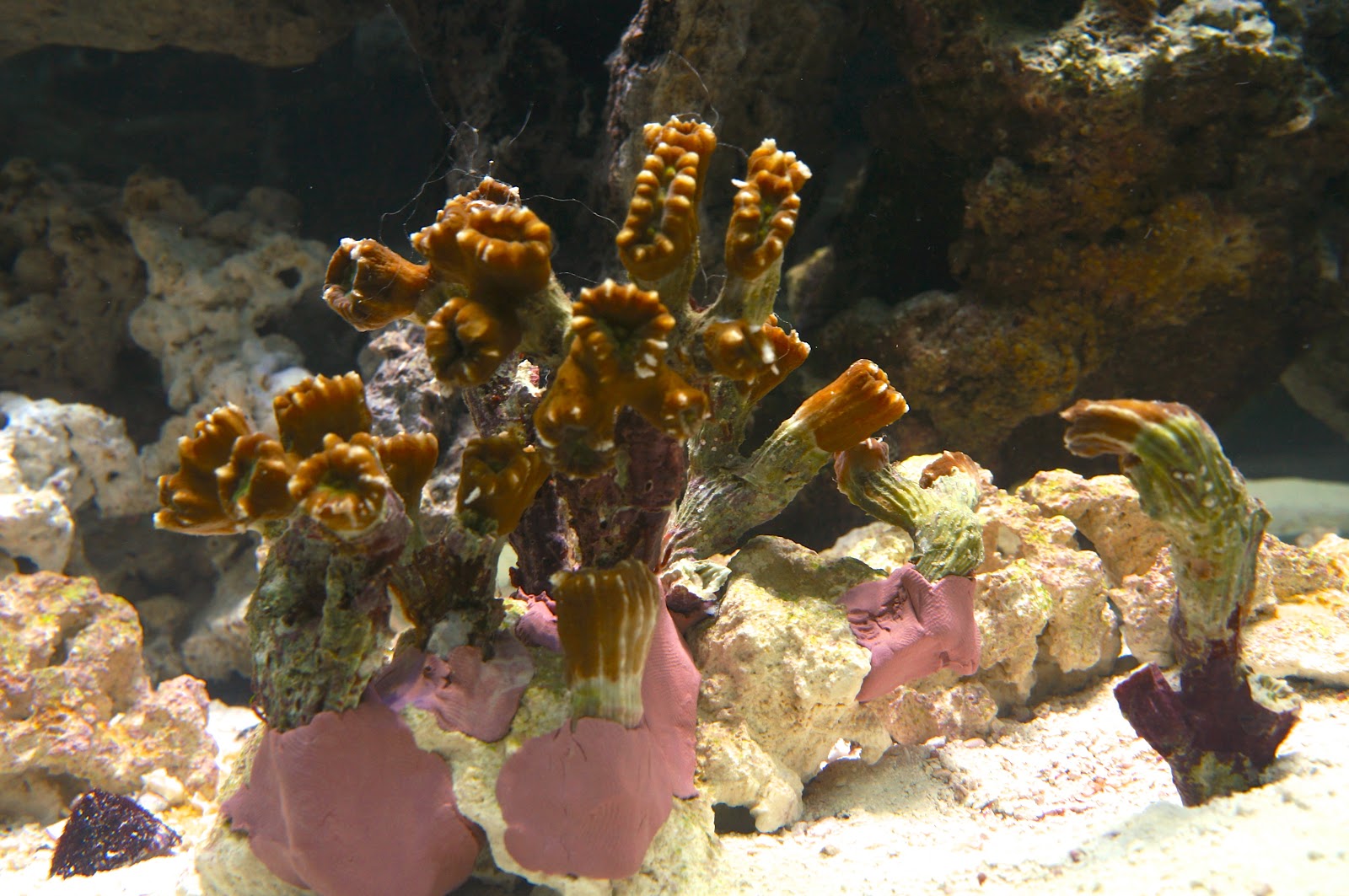This post is about the Temptations of Vince.
Was it the shrooms that made me pull the trigger? Was the devil's hand pushing me into the purchase? Well, both actually.
I wanted to add more beginner corals. So, I logged onto my favorite forum - www.aquariumadvice.com (AA) - asked some questions, read some previous posts, and made a list of possibilities.
I wanted quality items delivered to my door (only because this was the fastest way to feed my craving). Based on my continuous research, for the past two months, the best rated site for this is LiveAquaria. So on Wednesday evening, I placed the an order for delivery on Friday, and less than 24 hours from packaging in California, they arrived at my door.
 |
| Broken Candy Cane Coral |
Acclimation was immediately under way: first floating in their bags, then temperature-controlled drip acclimation to triple the volume of water in the shipment, and finally a coral dip to remove unwanted hitchhikers before placement into the display tank (DT). In order to keep corals, you must remember - the devil is in the details.
 |
| Taking a Dip - In Coral Rx - to Remove Pests |
Here are the profiles of my new additions (I also got a new type of snail):
Klyxum sp.
Care level: Easy
Type: Soft
Type: Soft
Lighting: Moderate to High
Waterflow: Medium to Strong
Waterflow: Medium to Strong
Origin: Indonesia
Temperament: Semi-Aggressive
Notes: Most of this coral's nourishment come from the symbiotic relationship with zooxanthellae dinoflagellates (a type of algae), which also give the coral its color. Diet can be supplemented with plankton. They will attack other corals within reach so care must be made to keep separate from other species.
 |
| The Next Morning |
Sarcophyton sp.
Care level: Easy
Type: Soft
Type: Soft
Lighting: Moderate to High
Waterflow: Medium
Waterflow: Medium
Origin: Indonesia (Aqua Cultured/Maricultured)
Temperament: Peaceful
Notes: Most of this coral's nourishment come from the symbiotic relationship with zooxanthellae dinoflagellates (a type of algae), which also give the coral its color. Diet can be supplemented with plankton.
 |
| The Next Morning |
Lobophytum sp.
Care level: Easy
Care level: Easy
Type: Soft
Lighting: Moderate to High
Waterflow: Medium to Strong
Waterflow: Medium to Strong
Origin: Indonesia (Aqua Cultured)
Temperament: Peaceful
Notes: Most of this coral's nourishment come from the symbiotic relationship with zooxanthellae dinoflagellates (a type of algae), which also give the coral its color. Diet can be supplemented with plankton.
Caulastrea furcata
Care level: Easy
Care level: Easy
Type: LPS
Lighting: Moderate
Waterflow: Medium
Waterflow: Medium
Origin: Fiji
Temperament: Peaceful
Notes: Has short sweeper tentacles that come out in the twilight. When these are extend the coral can grab supplemental feeding of brine shrimp or plankton.
There are four major classifications of corals (arranged from easiest to most difficult to keep): Soft/Leather Corals, Large Polyp Stony (LPS), Short Polyp Stony (SPS), and Non-photosyntetic (NPS) Corals. The Softs, LPS, and SPS need increasingly stronger lights as you get into the more difficult species, as well as higher levels of calcium and magnesium. NPS require feeding rather than receiving nutrients photosynthetically from the symbiotic zooxanthellae like other corals.
Getting corals used to an aquarium is a slow process. When first added to the aquarium the lights should remain off while the corals acclimate to the water quality and flow. They also need time to gradually adjust to the light intensity. This can be accomplished by both dimming the lights and placing the coral on the sand bed, furthest from the light source. If the coral is going to be moved to a higher location in the tank, the process should be a slow increase in height until the coral reaches its final placement.
As more life gets added to the tank, it is important to keep adding to the CUC in order to keep both algae and waste at bay. Variety in a CUC is also important, so I decided to add another type of snail to the union.
 |
| Newly Structured on a Piece of LR (Thanks Tasha) |
Getting corals used to an aquarium is a slow process. When first added to the aquarium the lights should remain off while the corals acclimate to the water quality and flow. They also need time to gradually adjust to the light intensity. This can be accomplished by both dimming the lights and placing the coral on the sand bed, furthest from the light source. If the coral is going to be moved to a higher location in the tank, the process should be a slow increase in height until the coral reaches its final placement.
As more life gets added to the tank, it is important to keep adding to the CUC in order to keep both algae and waste at bay. Variety in a CUC is also important, so I decided to add another type of snail to the union.
Nerite Snail (2):
Nerita sp.
Care level: Easy
Diet: Herbivore
Origin: Pacific
Temperament: Peaceful
Max Size: 1”
Notes: Remains small and rarely knocks over rocks or coral. Will feed off of the LR, but can also be seen eating film algae from the aquarium glass walls.
So the devil had his hand in this, but I think it was the right decision.
Next time we will discuss lighting!
So the devil had his hand in this, but I think it was the right decision.
Next time we will discuss lighting!





No comments:
Post a Comment